|
text ©2007
Vienna, March 29, 2007
Like the Hassler in Rome, the Sacher Hotel in Vienna is one of the few top hotels worldwide to have always been family-run. The Sacher is also unusual in another way. While most great hotels became famous for their hospitality first and then their cuisine, the Sacher Hotel owes its take-off to a cake. In actual fact, the hotel was opened in 1876 by the Eduard Sacher, the son of the inventive pastry chef Franz.
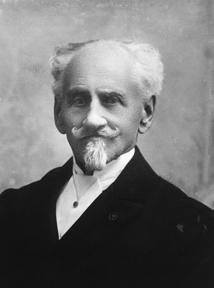 Franz Sacher Thanks to the generosity of the Austria Tourist Board in New York, the Vienna Tourist Board, and Reiner Heilmann, the Managing Director of the Sacher Hotel, Lucy Gordan visited the off-limits Sacher bakery and interviewed Franz’s present-day successor, Alfred Buxbaum, for Epicurean-Traveler.com. His charming wife Tamara, also a Sacher Hotel employee, was the translator.
LG: How many Sacher-Torte head chefs have there been all together?
AB: That’s a difficult question. I’ve held this position since 2003. Before me for 27 years it was a Mr. Pflieger. I began to work at the Sacher Hotel under him in 1989, when I was 19.
LG: A brief history of the Sacher-Torte?
AB: The first Sacher-Torte was created by Franz Sacher, a 16-year-old apprentice chef at the court of the Austrian State Chancellor Prince Clement Wenzel von Mitternich. The afternoon before an important banquet the head chef, who was supposed to invent a new sweet for the high-ranking guests that evening, fell ill, giving young Franz his chance of a lifetime. In spite of his success, however, Franz did not become a confectioner, but one of the greatest court chefs of all times. He is the father of “Viennese cuisine.”
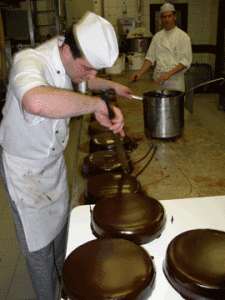 |
|
Alfred Buxbaum at work, photo © 2007 Lucy Gordan
|
LG: How did you happen to become a pastry chef?
AB: I loved baking cakes with my mother and I started very young as a pastry apprentice in a small café.
LG: Were there other pastry chefs in your family?
AB: No.
LG: Essential qualities for being a top pastry chef?
AB: A good professional relationship with colleagues; creativity and innovation.
LG: Other pastry chefs you admire?
AB: Franz Schumacher, who’s retired now but used to have his own pastry shop.
LG: When did the bakery move here from the Hotel’s kitchen?
AB: On March 15, 1999. It’s much better here. In the hotel’s kitchen it was very crowded. Here we have much more space. All the machines and ovens are only for us, for cakes, and not other foods. We even designed our machinery to fit our exact needs.
LG: How many people work under you?
AB: Twenty-one in production and 18 in ordering and packaging, which is all done by hand.
LG: Your typical day?
AB: I come here every morning at 6 AM; I prepare the day’s ingredients and then tell the chefs under me their jobs for that day. Next I control all the special orders, only private individuals not cafés or shops except at the Sacher Hotels and Cafés here in Innsbruck, Graz, and Salzburg, and at the Vienna airport. This Sacher-Torte you see here with a diameter of 80 cm. is a special order for a 75th birthday, but they are very popular for weddings.
Next on the agenda my team and I cover all the cakes with chocolate icing and then move on to doing our traditional [chocolate seals], seasonal or special-order decorations which include marzipan roses, Santa Clauses, and Easter bunnies. Last but not least, I deal with paperwork.
LG: Are you a sweet-tooth?
AB: Yes, especially ice cream, any kind of chocolate, and the Austrian warm dessert, “Kaiserschmarren“— shredded pancakes served with plum sauce.
LG: Tomorrow I’m going to visit the chocolaterie of the “Schokolade König” or “The Chocolate King”, Mr. Wolfgang Leschanz, who was a pastry chef at the Sacher Hotel and at Demel’s, perhaps the most famous Viennese café. Were you never tempted to open your own shop?
AB: No comment.
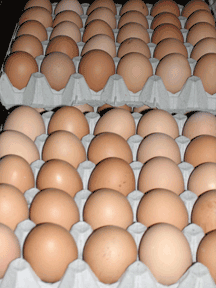 |
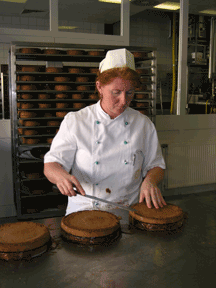 |
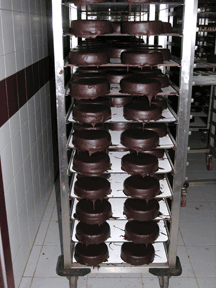 |
| photos © 2007 Lucy Gordan |
LG: Do you bake other types of cakes besides the Sacher-Tortes?
AB: Yes, four: the traditional Viennese Gewürzguglhupf flavored with ginger and other spices; Anna Sacher Schnitte, a fluffy layered sponge cake with orange and hazelnut praline cream filling with a hint of cointreau and covered in chocolate; a large chocolate-covered wafer Sacher Eck; Schokerlkuchen, a fudge cake with egg liquor. They and many other Sacher products can be ordered by e-mail: wien@sacher.com or from the website shop: www.sacher.com.
LG: How many Sacher-Tortes do you make everyday?
AB: On average we produce between 500-800 Sacher-Tortes per day. We make c. 350,000 every year. Our busiest time of the year is Christmas, when we bake c. 3,000 cakes a day. Annually we use more than 1 million eggs, 25 tons of castor sugar, around 75 tons of icing sugar, 64 tons of apricot jam, 23 tons of butter, and 20 tons of flour. We use three types of chocolate, which is free of preservatives and made by hand. As you can see, the dough is mixed in machines, but the rest is all hand-made, including the wooden boxes they’re packed by hand in.
LG: Where are your customers?
AB: Around a third are exported to Germany, the USA, Switzerland, Italy and Japan. DHL is our courier. Delivery time to any destination in the world is between three and six working days. For maximum freshness, Sachertortes should be stored at a temperature between 16 and 18 degrees Celsius. Once opened, they should be eaten within two weeks. The best way to enjoy them is with an cup of coffee topped with unsweetened whipped cream.
LG: Doesn’t it get monotonous to make the same cakes over and over again?
AB: No, every day is a new challenge.
LG: I know the recipe is a secret and that the filling between the layers is an apricot jam made exclusively for you, but what are the ingredients and the essential steps in baking a Sachertorte?
AB: Sorry, the recipe for the Original Sacher-Torte is strictly secret. It’s kept in a safe at the Hotel because lots of pastry shops worldwide sell Sacher-Tortes but not “The Original”. However, Alexandra Gürtler, the daughter of the present-day owner of the Sacher Hotel Elisabeth Gürtler,
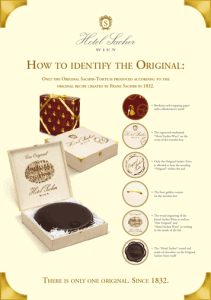 The original Sacher Torte, since 1832 the cookbook author Christoph Wagner, and the Hotel’s Executive Chef Hans Peter Fink included my simplified version in their cookbook, The New Sacher Cookbook: Favorite Austrian Dishes, published in 2005 and for sale on the Hotel’s website.
LG: Can you summarize the production steps for me?
AB: There are essentially 7 steps. 1) Break your eggs separating the whites from the yolk. 2) Mix sugar, chocolate and yokes together. 3) Add in whipped whites and flour. 4) Bake in an oven at 180 degrees for an hour. 5) Cut in two. 6) Spread the apricot jam filling between the two layers. 7) Cover with hot chocolate icing and let cool.
We make Sacher-Tortes in four standard sizes. The smallest called “Piccolo”, which means small in Italian, is 12 cm. in diameter, weighs 400 grams and serves 4; the others are 16 cm., 700 grams, and serves 6; 19 cm. in diameter, weighing a kilo, and serving 9; 22 cm. in diameter, weighing 1.2 kilos, and serves 12.
LG: Many top chefs have collections; what about you?
AB: I collect sunglasses and watches.
LG: If you hadn’t become a pastry chef, what profession would you have chosen?
AB: Probably a bank employee.
& & &
|






